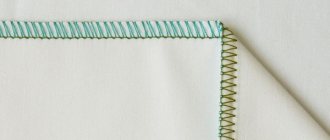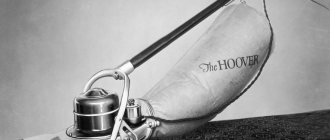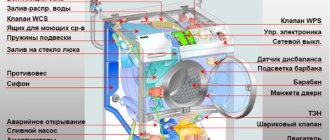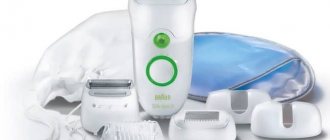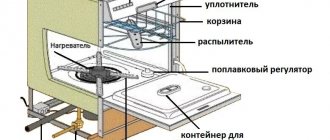Modern housewives prefer to use automatic washing machines to keep their laundry clean in a comfortable apartment, and semi-automatic ones if there are no public amenities. The designs of the devices are constantly being improved, the controls are becoming visually clear and simple.
However, sometimes operator errors occur and the wash quality deteriorates. Therefore, it will not hurt anyone to refresh your memory about the rules for using an SMA or a semi-manual unit.
- Features of the use of washing machines
- Preparing laundry for cleaning
- General washing instructions
- Putting SMA into operation
- Special programs
- Household cleaning products
- Prevention and maintenance of the washing machine
- Catalog of washing machines with reviews
Features of the use of washing machines
Machines that operate without human intervention perform all operations, including spinning and drying, themselves. The housewife’s job is to load the laundry, and at the end of the cycle, remove it.
Are you unplugging your washing machine?
Oh yes! No
Semi-automatic devices require the participation of the operator when moving to the next operation. Based on their design, the following types of machines are often purchased:
- frontal drum-type machines - they are in greatest demand among the population, as they have a variety of operating modes and useful options;
- units with vertical loading of laundry - they also have many fans;
- semi-automatic machines - like SMA, such machines are activator and drum.
The functional equipment of semi-automatic machines is constantly being improved: heating and the ability to set a washing program are added to the spinning and draining operations. And in design, modern models are almost no different from SMA.
There is a gradual elimination of the boundaries between the two previously different types of washing machines. Further in the text, all designated regulations apply to both designs of devices.
SMA
Sorted by cleanliness
Quite funny, but dirty things also need to be sorted by... cleanliness. But in fact, everything is much simpler and clearer than it seems at first glance. Items with stubborn stains should be washed in several stages or in an intensive mode (depending on the type of device).
It is much easier to wash clothes that are not particularly dirty or simply have an unpleasant smell; therefore, they require a different mode and even a different detergent (in some cases). Therefore, all things need to be further sorted into “dirty” and “very dirty”.
It is very convenient to have several containers for storing dirty laundry. You can put delicate items in one, heavy items in the second, and items that require more thorough washing, for example, in the third. At the same time, the containers can be small in size, which, in turn, will motivate regular washing.
At the very beginning, this whole sorting seems extremely complicated, but then the whole process seems to be “automated.” And, by the way, storage containers also help with this, since they significantly reduce the process of separating different “categories” of things from each other.
Preparing laundry for cleaning
A hint about washing modes is on the clothing label. When arranging things into batches, first empty your pockets of any objects. When sorting, consider the following:
- The tags are on the inside. On shirts - on the collar or on the left, on trousers - on the back. The labels indicate the temperature and washing mode, and the possibility of using bleach.
- Colored linen is separated from white according to the principle: dark shades - black, purple, blue, gray. Light colors - blue, purple, yellow and green. Jeans fade, they are washed separately.
- Small and light items - socks and tights - are washed separately from heavy ones: bath towels, trousers and jackets.
- Silk and delicate items are placed in a protective container or special bag to prevent damage to the fibers. In this form, things can be included in the cycle along with light-colored clothing.
The layout into 2 piles according to the degree of soiling allows you to turn on the quick wash mode and save on electricity. It is important to pay attention to the details of the clothing: if they are not securely fastened, they need to be sewn on or torn off.
Sorting and washing laundry
Washing in an automatic machine should be preceded by sorting the laundry by color and fabric composition. White items should be washed separately from colored items, and synthetics should not be placed in the drum together with cotton or linen items.
First of all, wash clothes made from synthetic fabrics or items with minimal contamination. Then you need to send light-colored cotton or linen items into the machine.
Lastly, wash items that may lose color during the washing process, as a result of which machine parts or those items may become stained, during the washing process the lint separates and remains on the internal parts of the machine.
After finishing processing of these products, you need to start the washing mode on the machine without loading laundry. This is necessary in order to wash off lint or paint from clothing from parts of a household appliance.
General washing instructions
Having completed the sorting, they begin to store the clothes. The machine manufacturer limits the capacity of the tub or drum to the dry weight of the laundry. It should be taken into account that a wool sweater of the same weight as cotton fabric will absorb more water and will be more difficult to wash. Therefore, when filling the machine, it is better to focus on the density of the load, and you should not compact it.
Recommended standards:
- synthetic fabrics are loaded to half capacity;
- woolen clothes - one third of the volume;
- The minimum weight limit for inexpensive SMA models is 1.5 kg of dry laundry.
Weighing things is rarely used in practice. Usually they look at the table.
| Name | Approximate weight, g |
| Jeans | 800 |
| Shirt | 300 |
| Handkerchief | 60 |
| Kitchen towel | 200 |
| Pillowcase | 200 |
| Sheet | 500 |
Overloading the machine will lead to its breakdown. Insufficient filling leads to vibrations and overuse of resources.
What information do labels on clothes contain?
The information contained on the labels of certain wardrobe items is required to be read. Because often it is this that allows you to keep things safe and sound for many years. As a rule, there are special signs on the labels, which in theory should help you navigate.
In practice, these designations for the average person are equivalent to road signs for a person who has never driven a car.
Therefore, here is a “decoding” of the most common icons on labels:
- basin – washing allowed;
- crossed out basin – washing is prohibited;
- basin with a dot - wash in water up to 30 degrees;
- basin with two points - up to 40 degrees;
- with three points – up to 50 degrees;
- basin with one line at the bottom - gentle wash;
- with two dashes – delicate wash;
- basin + hand – manual.
If the fabric itself is thin, and even covered with an unstable dye, then this will be indicated by a basin with the number 40 inside. This is equivalent to “wash at a temperature not exceeding 40 degrees.” If the fabric from which the product is made is coated with a stable dye, then this will be indicated by the number 60 with a similar picture.
The number 95 indicates that the thing can be boiled, and this will not worsen its condition. Well, the number 30 indicates that the product is made of wool, and it can only be washed at 30 degrees.
Drying is usually indicated by a square. If this geometric figure is drawn on the label, it means that drying is allowed. If the square is crossed out, this means that drying the item is prohibited. A square with a circle inside indicates that the clothes can be wrung out and dried using a washing machine. Accordingly, if this sign is crossed out, then such actions cannot be performed.
Putting SMA into operation
Through an external inspection, you should make sure that the washing machine is connected to all power supplies: water supply, sewerage and electricity. Load the prepared laundry into the drum and close the door tightly. The startup sequence is as follows:
- pour measured detergent into the retractable plastic container on the front panel; pour the conditioner into a specially designated compartment;
- insert the machine cord plug into the socket;
- open the water supply tap.
Further actions depend on the design features of various brands of SMA.
Control Panel
Some models start immediately after turning on the mode, others - by pressing the start button.
How to set the temperature
In modern washing machines, this operation is performed manually. There are devices in which the degrees are tied to the washing mode. Recommendations for heating water for various fabrics:
| Types of linen and clothing | Temperature, ºС |
| Delicate items – wool, silk | <30 |
| The entire range of home textiles: bedding, curtains, baby clothes | 30―40 |
| Heavily soiled items - children's and work clothes, kitchen towels | 40―60 |
| Disinfection of soft toys, medical linen and removal of difficult stains | Up to 95 |
We must remember that hot water causes fabrics to lose color and shrink. An increase in washing temperature is directly proportional to energy consumption.
Selecting the appropriate mode
There are from 5 to 20 or more types of laundry washing programs. They are installed using a round switch, which is located in the central part of the control panel. The choice of washing mode depends on the properties of the fabric being cleaned and includes the following parameters:
- solution temperature;
- duration and variability of activator rotation;
- spin speed;
- use of additives for various purposes.
Pre-sorting the laundry helps in selecting the right program - there are warnings about the prohibition of machine washing. Some manufacturers include automatic settings in their utilities for temperature, duration and speed of tissue dehydration. Once the mode is turned on, it cannot be changed until the cycle is completed.
Are you using citric acid?
Oh yes! No
Frequently used washing programs
Purchasing cars with advanced capabilities is not always a necessity, but rather a tribute to fashion: in practice, a limited list of modes is used. The price of a washing machine directly depends on the number of programs - the more there are, the higher the cost of the device. The minimum set is small:
- linen and cotton underwear at 60–95ºС for 2 hours with spin at maximum speed;
- synthetic fabrics in modes up to 60 degrees with the same washing duration and dehydration intensity as in the previous program;
- any things at a temperature of 30ºС.
Expert opinion
I work in the household appliance repair industry. Extensive experience in restoring washing machines and dishwashers.
Ask a Question
This set of utilities allows you to wash clothes with any degree of soiling. There are other modes that help clean fabrics efficiently and quickly.
Rules for using the machine
Most people, after purchasing, are convinced that they do not need instructions for using the washing machine and can figure out how it works on their own. But that's not true.
Before washing, be sure to read the instructions - they indicate important nuances and rules, if not followed, the machine may break.
Following the instructions will greatly facilitate the process of using the machine. The brochure indicates washing modes and capabilities of household appliances. You will quickly understand whether a particular fabric can be washed in your machine. And most importantly, you don’t have to think about which mode to run.
Special programs
SMA manufacturers try to take into account the wishes of each user. This is what determines the variety of washing modes.
Delicate drum rotation
The drum makes a rocking motion, simulating manual cleaning of products made from thin, lace and light fabrics from dirt. Mechanical impacts on the fibers are minimal, so the safety of things is guaranteed. Other features of the mode:
- soap solution temperature 30–40ºС;
- low washing speed;
- no spin or very low speed.
The program provides an economical mode in terms of energy and water consumption. For different machine models, the numerical values of heating temperature and drum rotation speed differ.
Selecting a program
Fast fabric refresh cycle
Divided into programs lasting 15 and 30 minutes. Suitable for washing lightly soiled clothes. In their absence - in order to give freshness to stale items or new, unworn items from the store. Other names for the mode are daily wash or express.
Distinctive features:
- possibility of simultaneous loading of laundry of different colors – water temperature up to 40ºС;
- It is recommended to fill the drum only halfway;
- spinning is carried out at maximum rotation speed.
The cost-effectiveness of the program is its main advantage. The benefit is not only in power consumption and water consumption, but also in the use of washing powder.
Pre-soak
Used for heavily soiled items and to remove old stains. This mode provides for the sequential implementation of two washes: preliminary and main. The powder is poured into 2 sections of the retractable block: during the first washing period, the product is consumed from one compartment, and during the second cleaning, from the other.
A special feature of the program is the need to keep the items placed in the drum for two hours at 30ºC. After soaking, the used solution is drained and the tank is filled with fresh water to continue the wash cycle.
Intensive treatment
This method of cleaning results in perfectly clean laundry. Before sending the stained item into the drum, it is treated with chemicals - gel, conditioner or bleach. At the first stage, set the temperature to 40ºС. On the second, 90–95º is determined and a long, intensive washing cycle is started. Push-ups occur at maximum speed.
Expert opinion
I work in the household appliance repair industry. Extensive experience in restoring washing machines and dishwashers.
Ask a Question
The listed modes are only part of an extensive list of programs. Each of them makes the process of washing clothes comfortable and tireless.
Selecting water temperature
The dirtier the item, the higher the water temperature should be when washing - this is what the voice of reason tells every person. In fact, the situation is not entirely like that, since some wardrobe items simply shed and change in every possible way due to high temperatures.
Yes, boiling water really kills germs and helps remove stubborn stains (but, by the way, not all of them), but it can also ruin the item.
Therefore, you need to follow the following simple rules:
- cold water = delicate wash and/or not too soiled clothes;
- warm water = light spin cycle and/or dark items;
- hot water = washing thick materials and/or heavily soiled textiles.
Fully automated “smart” washing machines differ from semi-automatic ones in that the temperature for each washing mode is already set on them. For example, for everyday or fast mode, water of 30-40 degrees is used.
Of course, if the correct temperature has already been set, then there should be no misfires, since modern “washing machines”, as a rule, function flawlessly.
Household cleaning products
An important part in maintaining cleanliness are powders, gels and other substances and reagents. Their assortment is huge, and to figure it out, you should follow some rules. Each product must correspond to a specific type of fabric and washing method:
- It is not recommended to use manual rinsing powders for use in SMA: a lot of foam is formed, which has a negative impact on the mechanism parts.
- Follow the dosage instructions on the packaging. Pay attention to the purpose of the product: for white or colored fabrics.
- We offer washing gels that have advantages over powders: complete dissolution in water, a gentle effect on laundry, and a lower content of allergens and substances harmful to the environment. Capsules with a jelly-like filling are also used - they are placed directly into the drum of the machine. Laundry tablets are made for use in cold water - economical and convenient.
- It is allowed, together with the main detergent, to use additional additives that increase efficiency: biological (at low temperatures), bleaches and stain removers. Rinse aids are used to make laundry soft and remove static charges.
All detergents contain the main component of the composition - a surfactant, it is this reagent that cleans the fabric from dirt. Other additives include flavors or fragrances, defoamers, dyes, and anti-scale agents. As the latter, individual powders are often used.
"Kalgon" for scale
Using Calgon for water hardness
The Calgon substance has a dual purpose: it prevents the formation of scale (salt deposits) on the surface of heating elements, and softens the water. The drug is available in powder, tablet, and gel forms. The package comes with a 96 ml measuring cup, with which a certain dose is added to the machine depending on the degree of water hardness:
| Salt content | Quantity: ml/piece of vessel |
| Small | 32/third |
| Average | 64/more than mid-level |
| High | 96/full |
Pour the powder into the main compartment - it is the most voluminous, along with the detergent. It is not recommended to place Calgon directly into the drum with laundry. A more convenient form is tablets. The positive effect of using the substance is achieved by using it in every wash.
Is a dishwasher profitable?
Oh yes! No
Detergents
The way a washing machine washes directly depends on the quality of the selected detergent. So, what you need to know about the powder and other products:
- Buy powders designed for a specific type of fabric. The packaging should indicate that the product is machine washable.
- For white clothes, use products that contain bleaches - they not only wash clothes and remove dirt, but also restore snow-whiteness.
- Wash multi-colored fabrics with products that do not contain bleach.
- When choosing between dry and liquid powders, it is better to give preference to the latter. Liquid products contain a high degree of concentration of active substances - they are better washed out of things.
- If you need to remove a heavy stain, use only high quality bleaches (for white fabrics) and stain removers.
- Use rinse aids to soften things.
Female hands poured powder in washing machine close-up
Prevention and maintenance of the washing machine
Compliance with the rules of care for household appliances is the key to long-term trouble-free operation. It is important to ensure that procedures aimed at maintaining the washing machine in working condition are carried out regularly. To do this you need:
- install a filter system at the water inlet to the SMA if the liquid is dirty;
- leave the hatch and tray slightly open, sometimes wipe the drum with a dry cloth - this will prevent the formation of mold and unpleasant odors;
- do not disconnect the device from the network by unplugging the cord from the socket; if you need to turn off the power to the machine during washing, you should press the pause button;
- clean the drain filter from small debris at least once a month;
- do not allow the drum of the machine to be overloaded with laundry - this entails increased vibrations and wear of parts, and deteriorates the quality of washing;
- Carry out regular inspection of the main components and respond to abnormal behavior of the ACS - this will help to timely identify faults and eliminate them.
It is important to use the washing machine correctly. To do this, first read the instructions for its operation, where there is comprehensive information about connecting, setting modes and detecting some problems in the operation of the device. All recommendations are applicable for any brand: Indesit, LG, Bosch, Beko, Zanussi, Samsung, Whirlpool, Hotpoint Ariston, Candy, Haier, Atlant, Ardo and others.
Brief guide to finish
The washing machine has been tested and the operating instructions have been studied. You can relax and devote yourself to what you love while the equipment cleans your things. But as practice shows, the process does not end there, because you need to take care of your washing unit, extending its service life as long as possible.
Here are some tips based on customer reviews:
- It is strictly prohibited to place heavy objects on the surface of the machine or to sit on it yourself;
- Do not open the detergent container when the unit is turned on;
- You should not change modes when the equipment is already working and has begun to draw water;
- You should take a responsible approach to choosing a detergent without abrasives or harmful chemicals.
By strictly following the recommendations specified in the article, the washing machine will last for decades, without contacting service centers or costly repairs.


